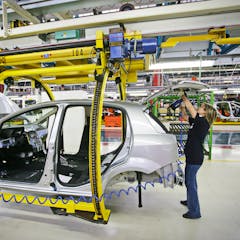
Articles on Australian manufacturing
Displaying 1 - 20 of 55 articles

If we’re going to prime a future-ready Australia, we need more research and development funding, and a diverse, highly skilled workforce. Are this year’s commitments in the right places?

I’ve been leafing through Foy & Gibson catalogues from the first four decades of the 20th century to try to understand what attracted Australian customers to wearing wool.

A heritage-listed hat factory has burned down in Surry Hills. The suburb was once a hub of fashion manufacturing.

Our interviews with ex-automotive workers reveal how economic change interrupts lives, casting people into new worlds of precarious work and long, indefinite journeys in search of security.

Australia’s abundant wind and solar resources mean we’re well placed to produce the hydrogen a green steel industry needs. But there are technical and economic challenges ahead.

There’s a strong case for more strategic local manufacturing. There’s little case for making cars and trains in Australia.

Rezoning to mixed-use residential development drove small manufacturers and creative producers out of the inner city. The result is less diversity of land uses, jobs and services where we most want it.

The skills shortage in the foundry sector shows there is a continuing demand for “traditional” trades.

Australia’s naval shipbuilding projects could anchor the future of advanced manufacturing in the national economy.

Even our most anonymous objects, like the portable electric drill, are sources of cultural expression. It’s time to learn their history.

How WA managed to emerge from the mining boom with an estimated debt burden of $40 billion is one of the West’s great mysteries. Or not, if you bother to look more closely.

There is a future for manufacturing in Australia - but we need to follow some international lessons to build a competitive knowledge-based economy.

With major employers heading offshore and employment numbers decimated, what will emerge from the ashes of Australia’s manufacturing industry? And what role should manufacturing play in the federal government’s…

As Australian prime minister Tony Abbott arrives in Canada to talk investment and trade, both countries are facing similar challenges to their respective manufacturing bases, particularly in the automotive…

As Australia laments the decline of its manufacturing sector, China is actively taking steps to accelerate its move up the value chain. Historically a low-cost operating environment, China was once an…

In the lead up to the budget, the story of crisis has been hammered home, but there’s more to a country than its structural deficit. So how is Australia doing overall? In this special series, ten writers…

Australia faces a fall in living standards unless policy action is taken. This is due to de-industrialisation and loss of economic complexity. The higher the economic complexity, the stronger the economy’s…

The recent decisions by Ford, Holden and Toyota to cease manufacturing in Australia have raised serious concerns for the thousands of Australian businesses who work in the automotive supply chain. Manufacturers…

The debate about the future of Australia’s Renewable Energy Target (RET) has largely focused on the issue of immediate costs to business. But if we’re thinking about Australia’s long-term economic interests…

Australia’s economic challenge is now starkly apparent. In the wake of a diminishing contribution to our national income by primary commodity exports (think iron ore, coal), we need to “rebalance” the…
